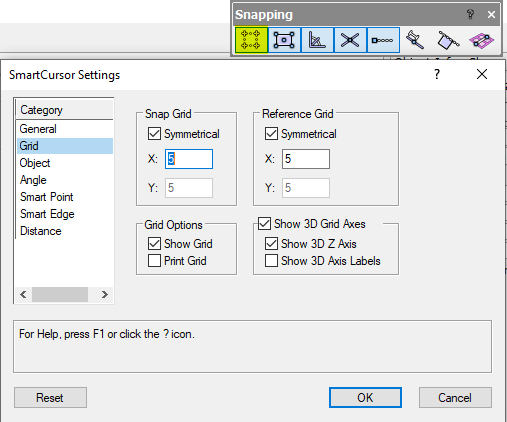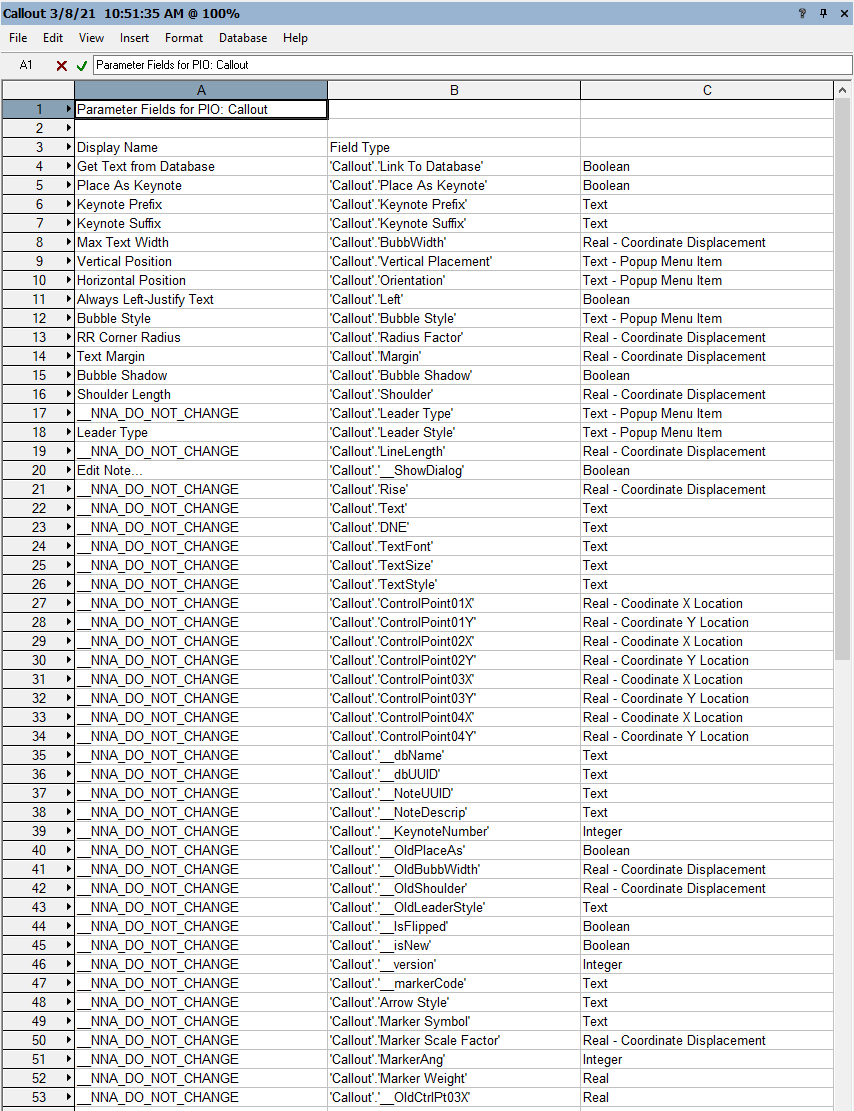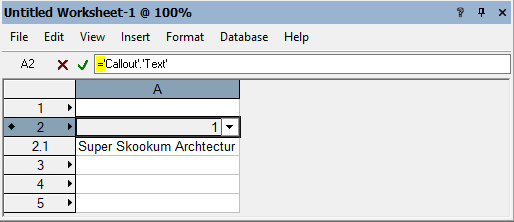
Boh
Member-
Posts
1,704 -
Joined
-
Last visited
Content Type
Profiles
Forums
Events
Articles
Marionette
Store
Everything posted by Boh
-
I’m interested to know this too. I’ve had to revert to the less smart grid bubble tool to get duplicate grids.
-
The icons at the top of columns indicate the sorting order. At the moment your are primarily sorting by column G then D then E then F. Do you need all that? It's not so straight forward to get a particular row in a particular location in a data base spreadsheet. To do this I have sometimes resorted to not have any sorting of columns then the rows will arrange in the objects draw order. Send something to the back or front of a drawing and with a recalculate the item will appear either at the bottom or top of the worksheet. But this only works if there is no other sorting. Alternatively you could add another field to the record you are reporting on called "List order" or something. Make a column in your worksheet for that field and make it the primary sorting column. Put numbers in the field to get the sort order you want. If you just want one row to be at the bottom it just needs to have a higher number than all the others. Once you are done sorting you can make the column width for the "list item" column have zero width which will hide it away.
-
Yes the detailer tool is great. A relatively new addition to OzCad. Both WinDoor and the detailer take some investment to get the most out of but well worth the effort. They are the OzCad tools I use the most.
-
Space Tool, editable fields not appearing in object info palette
Boh replied to Lorenzo S's question in Troubleshooting
Have you tried settings > advanced > and choosing which items to display in the oip? This may be a user preference so might explain how it looks different in colleague machine.- 1 reply
-
- 1
-

-
And if you are not opening from a template then you are stuck with the vw default blank file which I don’t think is easy to change. I suggest create a template. We even have a “blank” office template with no geometry in it and no classes or layers. It does however have our custom default settings for tools and snap settings, some scripts and custom smart markers and data tags. Its a real time saver to have this already set up when you start a new document.
-
Wishlist - Custom automatic viewport naming
Boh replied to Gregovitch's question in Wishlist - Feature and Content Requests
I think the rename all vp script you just posted is slightly out of date as the one I posted calls up som 2018 edits that the one you posted doesn't have. Though not sure it makes much difference 🙂 What numbering standard does the renumber sheet layers script use? Or is this customisable? Cheers -
Wishlist - Custom automatic viewport naming
Boh replied to Gregovitch's question in Wishlist - Feature and Content Requests
So yes I just did a quick test on both Section viewports and Detail viewports and the rename script seems to be working without messing with the smart marker navigation. @Andy Broomell You can start renaming your vps again 🙂 Kudos to @michaelkfor writing the script in the first place and @Matt Panzerfor submitting the bug report. There is another similar script that Michael wrote that will rename all sheet layer viewports in a file. This one is super handy too! I think it goes like this. (Not sure if it's the most up to date version). Procedure ViewportRename; {Badly Scripted by Michael Klaers. Updated Aug 2, 2015} {This script will take all selected viewports and change the name of those viewports to be (Sheet Layer) (Drawing Number) (Drawing Name) This version tries to force the name to appear immeidately in the name field, data tab, OIP when only one VP is selected. Prior to this version the new name appeared immediately in the Nav Palette, but not in the name field.} {Forked version. Sept 10 2018 This version will rename all viewports in the drawing regardless of what is currently selected.} Var VPDwgTitle,VPName,BText,VPNum : String; h,hh: Handle; ViewportLayer: Handle; ViewportLayerString: String; Procedure RenameVP(h : HANDLE); Begin {*********** BEGIN Procedure ***********} ViewportLayer:= GetLayer(h); ViewportLayerString:= GetLName(ViewportLayer); VPDwgTitle := GetObjectVariableString(h, 1032); VPNum := GetObjectVariableString(h, 1033); ResetObject(h); { Message('Viewport Handle: ',h,chr(13), 'Layer Handle: ',ViewportLayer,chr(13), 'Layer Name: ',ViewportLayerString,chr(13), 'VP Num: ',VPNum,chr(13), 'VP Name: ',VPDwgTitle); } SetName(h, Date(2,2)); SetName(h, CONCAT(ViewportLayerString,' ',VPNum,' ',VPDwgTitle)); SetDSelect(h); {These two commands are just here to force the new name to appear in the } SetSelect(h); {name field immediately. They can be deleted w/o consequence} End; {*********** END Procedure ***********} Begin {*********** Main Program ***********} ForEachObject(RenameVP,((T=VIEWPORT) )); End; Run(ViewportRename); -
My workaround is to trace the section cut in the vp annotations and then turn the site model visibility to off. Not particularly clever and it means if I move the section or change the dtm then I need to retrace but the time spent retracing can be less than waiting for a vp through a dtm to update. Hadn’t tried the method with the resolution and OpenGL settings. I’ll give that a go next time.
-
-
Hey @Pernille I couldn't reproduce what you are getting from the files you posted. When I set the page set up to A3 landscape I managed to print an A3 landscape hardcopy as it should have. The only issue I found is when I print A3 landscape to Adobe pdf it changes to A4 portrait. But I never use print to pdf I always use export or publish to pdf where I don't get this issue. Is this happening just on your vectorworks? Are others having the same problem. There is a new service pack available for vw2021. Have you upgraded to that yet? Did vectorworks tech support suggest anything? I would think they might suggest a reinstall.
-
I had to add a bracket to the start of this line to get it to work:
-
Wishlist - Custom automatic viewport naming
Boh replied to Gregovitch's question in Wishlist - Feature and Content Requests
I can't write scripts but If you have the script, or can copy it from this forum, then importing it into vw is very easy. There are two ways to do it. The simpler way is file specific and the other slightly more involved way allows the script to be used on any open file. File specific method: (Good for scripts that you are unlikely to used elsewhere, or good to bring into template files so will be available in any files created from the template). Go to the resource manager. Hit "New Resource" in bottom left of window Choose new script Select a script palette to place the new script in, or choose "New Palette" Assign a name to the script Paste the script into the script editor and hit ok. Double click on the script to activate it. To display the palette in your workspace (rather than just in the RM), go to the Window menu and at the bottom under script palettes put a check mark next to the palette you want to see in the workspace. This process makes the script accessible in the file you are working on only. You can import into other files via the RM just like any other resource. To add the script as a plugin to your workspace as a menu command so they are useable with any file at any time: Go to the Tools menu and hit Plug-ins>Plug-in manager. Hit New and name the new plug-in. Hit ok. Hit edit script and paste the script into the script editor. This brings the plug-in into your VW but you still need to add it to your workspace to use it: Close the Plug-in Manager and go to Tools>Workspaces. Edit the workspace you want to add the new plug-in to. In the list of menu commands on the left find the plug-in (probably under "Miscellaneous". Drag the plug-in across to the right and place it in the Menu where you want it and hit OK. The script is now available in your workspace. Single click on it to activate it just like any other menu command. -
Do you have some object there that are in a class set to invisible? The fit walls command will fit to all objects regardless of their current visibility settings.
-
Yes this is very useful. Sometimes with larger file size PDFs you get thousands of polys from the ungrouped pdf. If you run a purge you can also get rid of a lot of the duplicated coincident line work to make it more user friendly.
-
Not sure why your dimensions have different size markers to your callouts but if you make the design layer scale the same as your viewport scale then this problem should go away.
-
The Australasian vw has both the native and WinDoor options but, like @Kevin K we only use WinDoor. Im not very familiar with the native options and I’m sure there will be some things that you can do with those that will not be available in WinDoor, or will be a bit different. However WinDoor services our requirements pretty well and it’s just not worth complicating files with different door or window pios. In fact we have removed the native options from the office workspace.
-
Keynotes: Best Practices Question
Boh replied to hollister design Studio's topic in General Discussion
I also really like each sheet to have its own keynote legend. In general contractors do too. Everything immediately relevant to the drawing is actually on the drawing. It just makes the drawings more user friendly IMHO. Main contractors also often need to distribute drawings to various sub contractors. Often a centralised main notes sheet is forgotten about. The “new” notes manager can now also standardise notes across a file so there is less chance of error in duplicating notes. I agree with @hollister design Studiotho that it would be nice if there was a way to standardise keynote numbering so the same keynote on different sheets could have the same number. -
Yes keeping all sheet layer objects in the none class has some limitations as @jeff princementions. However our sheet layers only contain a titleblock, viewports, a scale bar and some notes, all of which can happily live in the none class. Legends go in vp annotations where the power of class attributes and overrides can be utilised. I should have added in my earlier post that as well as keeping all sheet layer objects on the none class we, as an office rule of thumb, we also keep the none class the active class. This avoids the issue with container objects inadvertently being created in odd classes and it also doesn’t matter what the current class visibilities are set to when you go to publish drawings as all sheet layer info will be visible. In an office set up with multiple cad technicians often working on each other’s drawings, keeping it simple is really important to avoid errors.
-
I recommend putting all sheet layer objects on the none class. That way they will always be visible. Only class stuff that’s on design layers or in vp annotations.
-
If I think sometimes if a record name or field changes then older files opened in newer version get a "Legacy" formula inserted. I think it is usually just a matter of updating the record.field names in the worksheet database row. The script I posted in this thread back in August 2019 still works and if you run it on an object it will give you all the available record fields/parameters for an object that can then be used in worksheet formulas. perhaps try running that script then editing the worksheets that don't work with the formulas listed by the script. E.g. Running the script on a callout gives:
-
Add alternating row colors option to database worksheets.
Boh replied to Bruce Kieffer's question in Wishlist - Feature and Content Requests
upvoted! -
Update on this. With the new data manager it is now possible to update notes in a project file from the data base. If you change a callout which is linked to the database vw will ask you if you want to update the database with the changes but also all the other callouts linked to the same note.' I'm still playing with it but it worked well on the first project I tried using the data base manager. One question I have is if multiple files have notes linked to the same database will notes in the other files also be updated if the notes database is updated. That could be problematic as you might not want those notes changed in different files. I'm still using worksheets to globally edit callouts however. Particularly keynote callouts. I use a lot of keynotes on different legends and the worksheet really help check if the keynotes are going to the correct legend.
-
-
Title Block Revision questions.
Boh replied to hollister design Studio's topic in General Discussion
You can use the title block manager to do multi-sheet revisions. The manager interface is a bit non-intuitive. First thing to do when the dialogue opens is to hit the "Select Sheets" button which is right at the bottom of the dialogue. Once you have selected which sheets you want to add revisions to you can do the same revision to all of them. -
Just want to say that those who are willing to put themselves out for no recompense other than a thankyou is a really amazing community minded way to be and I for one really appreciate people like yourself, Pat and Jesse, who have that scripting skillset (amongst other skills) and are willing to put their time in. You guys are the reason this forum is so good! For myself, one who finds scripting just utterly confusing, I have really benefited from that generosity. In recompense I do try to respond to questions on the forum where I might have some experience or knowledge to offer (just not in scripting!). For non-scripters like myself, who don't have an understanding of what it takes to do some tasks, something may seem simple on the surface to a novice but in actual fact is hugely complicated. I hope I have never asked or expected anyone to over invest in something that!




